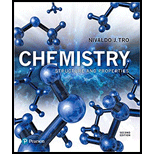
Concept explainers
Interpretation:
Different categories of crystalline solids must be explained.
Concept introduction:
Solids are classified into two categories: Crystalline and amorphous according to the range of order present in the arrangement of constituent particles present in them.
Crystalline solids have a regular arrangement of constituent particles which repeats itself over the whole crystal that is they have long range order. Examples of crystalline solids include NaCl and quartz.
Amorphous solids have short range order which mean that regular and repeating arrangement of constituent particles is observed over short distances in the solid. Overall pattern of arrangement of constituent particles is disordered. Examples include glass, rubber and plastic.
Crystalline solids can be further classified on the basis of intermolecular forces into:
- Atomic solids
- Molecular solids
- Ionic solids
- Covalent solids
- Metallic solids
Want to see the full answer?
Check out a sample textbook solution
Chapter 12 Solutions
Solutions Manual For Chemistry: Structure And Properties
- Elemental carbon has one gas phase, one liquid phase, and two different solid phases, as shown in the phase diagram: (a) On the phase diagram, label the gas and liquid regions. (b) Graphite is the most stable phase of carbon at normal conditions. On the phase diagram, label the graphite phase. (c) If graphite at normal conditions is heated to 2500 K while the pressure is increased to 1010 Pa, it is converted into diamond. Label the diamond phase. (d) Circle each triple point on the phase diagram. (e) In what phase does carbon exist at 5000 K and 108 Pa? (f) If the temperature of a sample of carbon increases from 3000 K to 5000 K at a constant pressure of 106 Pa, which phase transition occurs, if any?arrow_forwardPhase diagrams for materials that have allotropes can be more complicated than those shown in the chapter. Use the phase diagram for carbon given here to answer the following questions. (a) How many triple points are present and what phases are in equilibrium for each? (b) Is there a single point where all four phases are in equilibrium? (c) Which is more stable at high pressures, diamond or graphite? (d) Which is the stable phase of carbon at room temperature and 1 atmosphere pressure?arrow_forwardA common prank on college campuses is to switch the salt and sugar on dining hall tables, which is usually easy because the substances look so much alike. Yet, despite the similarity in their appearance, these two substances differ greatly in their properties, since one is a molecular solid and the other is an ionic solid. How do the properties differ and why?arrow_forward
- Silicon carbide, SiC, is a very hard, high-melting solid. What kind of crystal forces account for these properties?arrow_forwardDescribe the unit cell of lithium (see Figure).arrow_forwardLithium hydride (LiH) has the sodium chloride structure, and the length of the edge of the unit cell is 4.086 108 cm. Calculate the density of this solid.arrow_forward
- Classify each substance in the table as either a metallic, ionic, molecular, or covalent network solid: Substance Appearance Melting Point Electrical Conductivity Solubility in Water X brittle, white 800 C only if melted/dissolved soluble Y shiny, malleable 1100 C high insoluble X hard, colorless 3550 C none insolublearrow_forwardMetallic barium has a body-centered cubic structure (all atoms at the lattice points) and a density of 3.51 g/cm3. Assume barium atoms to be spheres. The spheres in a body-centered array occupy 68.0% of the total space. Find the atomic radius of barium. (See Problem 11.93.)arrow_forwardDecide what kind of crystalline solid each element or compound in the table forms, and what kind of force holds the solid together. Then, rank the solids in order of decreasing melting point. That is, select "1" next to the solid with the highest melting point, "2" next to the solid with the next highest melting point, and so on. (You may need to use the scrollbar to see all the choices.) element or compound type of solid formed ZnCl₂ ionic CH₂Br₂ 0₂ molecular molecular force holding the solid together dipole dipole covalent bonding melting point of solid 3 (lowest) 2 1 (highest) 5arrow_forward
- Metal X has an edge length of 4.1303 Å and a diameter of 2.92 Å. Assume that there is one atom per lattice point, determine the crystal structure of metal X.arrow_forwardDecide what kind of crystalline solid each element or compound in the table forms, and what kind of force holds the solid together. Then, rank the solids in order of decreasing melting point. That is, select "1" next to the solid with the highest melting point, "2" next to the solid with the next highest melting point, and so on. (You may need to use the scrollbar to see all the choices.) element or compound Os 0₂ HOC1 type of solid force holding the solid formed together ? ? ? v ? ? ? X melting point of solid ? ? ?arrow_forwardExplain how the co-ordination number affects or determines the stability of a crystal structure.arrow_forward
 Chemistry by OpenStax (2015-05-04)ChemistryISBN:9781938168390Author:Klaus Theopold, Richard H Langley, Paul Flowers, William R. Robinson, Mark BlaserPublisher:OpenStax
Chemistry by OpenStax (2015-05-04)ChemistryISBN:9781938168390Author:Klaus Theopold, Richard H Langley, Paul Flowers, William R. Robinson, Mark BlaserPublisher:OpenStax Chemistry: Principles and PracticeChemistryISBN:9780534420123Author:Daniel L. Reger, Scott R. Goode, David W. Ball, Edward MercerPublisher:Cengage Learning
Chemistry: Principles and PracticeChemistryISBN:9780534420123Author:Daniel L. Reger, Scott R. Goode, David W. Ball, Edward MercerPublisher:Cengage Learning General Chemistry - Standalone book (MindTap Cour...ChemistryISBN:9781305580343Author:Steven D. Gammon, Ebbing, Darrell Ebbing, Steven D., Darrell; Gammon, Darrell Ebbing; Steven D. Gammon, Darrell D.; Gammon, Ebbing; Steven D. Gammon; DarrellPublisher:Cengage Learning
General Chemistry - Standalone book (MindTap Cour...ChemistryISBN:9781305580343Author:Steven D. Gammon, Ebbing, Darrell Ebbing, Steven D., Darrell; Gammon, Darrell Ebbing; Steven D. Gammon, Darrell D.; Gammon, Ebbing; Steven D. Gammon; DarrellPublisher:Cengage Learning ChemistryChemistryISBN:9781305957404Author:Steven S. Zumdahl, Susan A. Zumdahl, Donald J. DeCostePublisher:Cengage Learning
ChemistryChemistryISBN:9781305957404Author:Steven S. Zumdahl, Susan A. Zumdahl, Donald J. DeCostePublisher:Cengage Learning Chemistry: An Atoms First ApproachChemistryISBN:9781305079243Author:Steven S. Zumdahl, Susan A. ZumdahlPublisher:Cengage Learning
Chemistry: An Atoms First ApproachChemistryISBN:9781305079243Author:Steven S. Zumdahl, Susan A. ZumdahlPublisher:Cengage Learning





